| |
Pete's peak
performance for charity
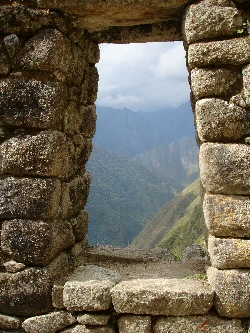 This
year vet Peter van Dongen did his third Charity Challenge Trek, with the British organisation
Across the Divide (AtD). Having previously done the Husky Sledding Trek, in the Norwegian
Arctic, and the Desert Trek, in Namibia, he went to Peru for a 6 day trek, ultimately leading
up to the Lost City of the Incas, Machu Picchu! It was to be a mentally and physically
challenging, but, at the same time, enormously satisfying and amazing trip. This
year vet Peter van Dongen did his third Charity Challenge Trek, with the British organisation
Across the Divide (AtD). Having previously done the Husky Sledding Trek, in the Norwegian
Arctic, and the Desert Trek, in Namibia, he went to Peru for a 6 day trek, ultimately leading
up to the Lost City of the Incas, Machu Picchu! It was to be a mentally and physically
challenging, but, at the same time, enormously satisfying and amazing trip.
This year I had chosen the charity RAIN, a local small animal charity, close to
the veterinary practice where I work.
The main aim of
RAIN
is to rescue, rehabilitate and re-home animals, and to provide any help that is needed in terms
of general care and veterinary treatment. For further information about
RAIN
please go to their website at
www.rain.org.uk
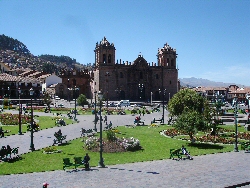 Preparation Preparation
I started some
months ago, getting fit enough again, by doing weekly exercise at the gym, going for the odd
run or bike ride, doing agility with my dog, and keeping an eye on general fitness, nutrition
and health. I also bought some further supplies of trekking gear, energy powders and bars and
wet wipes and other necessary items.
By the end of May, I was ready, apart from a persistent cough/cold. I took it
easy for a few days and went to Heathrow to meet up with my fellow trekkers. Some of these had
done treks before, but most were 'trekking virgins'.
Lift off
We had a long hard day of
travelling ahead of us, including flights to Madrid first, then on to Lima, the Peruvian
capital on the coast at sea level. From the plane we saw the Peruvian jungle below us,
including the river systems which make up the start of the mighty Amazon River. After that we
flew over the Andes mountain range, very impressive! We stayed at a hotel for the night,
getting our first information and briefing about the actual trek from the trek leader that
night. Max Milligan, a Brit who has lived in Peru for the last 24 years, is an expert on Inca
and Peruvian history and culture and has written several books on the subject. The following
day we moved on to Cuzco, the Inca capital, by flying back over the Andes, and further inland
to a height of some 3300m!
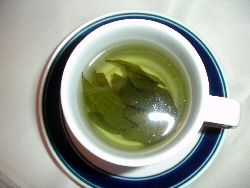 As
soon as we came off the plane, we noticed the effects of altitude, which we had been warned
about. You get a feeling of being short of breath straight away, and every day exercise becomes
a strenuous affair. Also, people can suffer from various more serious side effects of living at
altitude, such as headaches, dizziness, nausea and in severe cases even more serious symptoms
such as pulmonary or cerebral edema! I only had the headache and after a cup of coca tea - said
to reduce the effects of altitude sickness - we walked around town for a bit. We then boarded a
coach for a trip higher into the mountains, where we had a spot of lunch at 3800m! I felt dizzy
as I walked to the one and only loo at this point. As
soon as we came off the plane, we noticed the effects of altitude, which we had been warned
about. You get a feeling of being short of breath straight away, and every day exercise becomes
a strenuous affair. Also, people can suffer from various more serious side effects of living at
altitude, such as headaches, dizziness, nausea and in severe cases even more serious symptoms
such as pulmonary or cerebral edema! I only had the headache and after a cup of coca tea - said
to reduce the effects of altitude sickness - we walked around town for a bit. We then boarded a
coach for a trip higher into the mountains, where we had a spot of lunch at 3800m! I felt dizzy
as I walked to the one and only loo at this point.
There were three Peruvian ladies selling beautiful colourful stuff though, like
woolly hats, socks and other souvenirs, as I were to find out was the usual situation, wherever
I went.
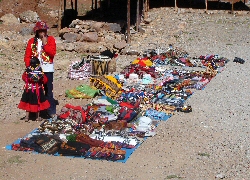 We
followed the Urubamba river up to Ollantaytambo, the most perfectly kept proper Inca village in
Peru. The small cobbled streets don't seem appropriate for big coaches to drive through, but
the villagers welcome tourists. As soon as you come off the bus, you get 'attacked' by people
selling everything from walking sticks to coca leaves and from hats to ponchos, and more. We
followed the Urubamba river up to Ollantaytambo, the most perfectly kept proper Inca village in
Peru. The small cobbled streets don't seem appropriate for big coaches to drive through, but
the villagers welcome tourists. As soon as you come off the bus, you get 'attacked' by people
selling everything from walking sticks to coca leaves and from hats to ponchos, and more.
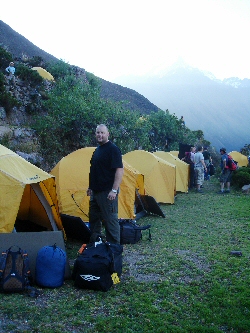 We
got off the bus and walked for the first time in several days, up to our first camp site for
the night, on a terraced mountain side, Cachicata, at 2800m. We were surprised to find that
there were toilets, and even showers, as well as a dining room. Guess they wanted to make us
feel slightly ‘civilized' at this stage. Things were to change soon! By 9pm we were all in bed,
in shared tents, which had been put up by the local staff. We
got off the bus and walked for the first time in several days, up to our first camp site for
the night, on a terraced mountain side, Cachicata, at 2800m. We were surprised to find that
there were toilets, and even showers, as well as a dining room. Guess they wanted to make us
feel slightly ‘civilized' at this stage. Things were to change soon! By 9pm we were all in bed,
in shared tents, which had been put up by the local staff.
Ruins
Early in the
morning on the next day we were woken up by the local helpers with a friendly good morning,
some hot coca tea, and a plastic bowl with ‘Aqua Caliente', or hot water, to have a quick
morning wash. This was to be the regular morning routine for the next week!
After breakfast we walked back into Ollantaytambo, to see some more of the
village and to visit the famous Inca Ruins there. Here we had a two hour tour of the ruins,
whilst a local guide told us all about the Inca culture, history and religion. Afterwards we
went into the centre of the village, where most of the streets and the houses are still exactly
the way they were during the time of the Incas.
We visited two very small houses, from a small courtyard, just off one of the
many tiny, narrow streets. The people living in these houses allow AtD to bring visitors,
probably for a small fee, to show their way of living and to try and sell some of the goods
they produce. The houses were basically one room only, with living and sleeping quarters, as
well as kitchen and other areas in various corners.
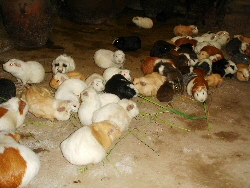 The
most eye-catching feature of these houses were the 30 or so Guinea Pigs running around, loose
and free, on the floor. They were eating some grass provided, but served as food themselves, at
special occasions, like traditional feasts. Roast Guinea Pig, or ‘cuy', is a delicacy in Peru.
Another important feature, carefully positioned in small niches in the wall, is a collection of
skulls of the forefathers of the people living there presently! They keep watch over the
property and the people within. Kind of creepy in our minds, but totally normal for them. The
most eye-catching feature of these houses were the 30 or so Guinea Pigs running around, loose
and free, on the floor. They were eating some grass provided, but served as food themselves, at
special occasions, like traditional feasts. Roast Guinea Pig, or ‘cuy', is a delicacy in Peru.
Another important feature, carefully positioned in small niches in the wall, is a collection of
skulls of the forefathers of the people living there presently! They keep watch over the
property and the people within. Kind of creepy in our minds, but totally normal for them.
After our visit I bought some small souvenirs from the proprietor of the second
house and went into the centre of the village for a break. We had coffee and were ‘attacked' by
various street venders trying to sell us stuff. I, and many others with me, bought a walking
stick, as well as a poncho and a hat. These items are incredibly cheap, compared to what we are
used to in the UK. We then took the coach further into the surrounding mountains, to a height
of 3000m. After a picnic, we started to walk again, for only a couple of hours this afternoon.
Camp was ready for us, at 3200m, near a small village, with a school and some toilets and
showers. I did have a shower, even though there was only ice cold water! Still, better than
nothing. After some afternoon tea and a dinner of mash and stew, we all went to bed at about
8.30pm, which was to be the norm for the next few days.
Humbling experience
The next morning
we had breakfast with ‘eggy bread', before we experienced something very special. The local
school, visited by some 30 children or so, was right where we stayed the night. Some of the
kids had to walk for two hours, over the mountains, on flip flops, to reach school! No school
runs by mums in their 4x4s here!
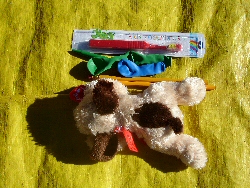 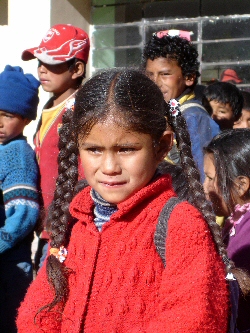 We
had all been asked by AtD to bring some small items which might be of use to the local
children. Most of us had brought some simple things, such as children toothbrushes, balloons,
elastic hair bands, pencils, notebooks or small fluffy toy animals. All these items were
divided into 30 small piles on a sheet laid out before the kids. There was no running, no
shouting, no fighting, no jealousy, no nothing. Even I started to like kids, and that is saying
something! We
had all been asked by AtD to bring some small items which might be of use to the local
children. Most of us had brought some simple things, such as children toothbrushes, balloons,
elastic hair bands, pencils, notebooks or small fluffy toy animals. All these items were
divided into 30 small piles on a sheet laid out before the kids. There was no running, no
shouting, no fighting, no jealousy, no nothing. Even I started to like kids, and that is saying
something!
After some words by the local guide, one by one the kids were invited to choose
a pile of items from the sheet. Again, this was a very calm affair, and you wouldn't believe
the joy and happiness on these kids' faces when they collected what we would regard as
something so very tiny, cheap and unimportant. Most of them got a pencil, two balloons, a
couple of elastics and perhaps a small toy. It was a very humbling experience for us all. We
also donated a football and a rugby ball to the school. Afterwards the children all sang a song
or two for us. Most of us had tears in our eyes by then. It made us all realise what's
important in life, and that the value of 'things' is so very relative to what kind of world we
live in.
Afterwards we started our long hard walk for the day. We saw the Inca Ruins, at
3400m, where we were to have lunch, from the campsite, but it was about four hours walking
still! These ruins have only been cleared in the last few years, with the help of AtD, after
they helped discover them in the first place. There our leader Max told us something about the
history of the Incas.
After lunch we went further uphill. For some this was just too much, at least at
this altitude, and the packhorses we had with us for most of the trek, came in very handy,
either for people to ride, or at least for our packs to be carried by, when we were totally out
of breath. At 3800m we found a lone old busker, playing his zither type instrument and singing
local folklore songs! We gave him some fruits and other small foodstuffs, as well as some local
money. We finally reached our campsite, at Corimarca, just before dark. It was perched on a
mountain side, with the most amazing views.
At dinner time we saw another novelty: Max getting presented with a roast guinea
pig, perfectly perched on top of some roast potatoes, by the locals, the children of whom were
Max' godchildren. This was then some sort of offering to him, as a sign of respect. Some of the
trekkers did not particularly like this idea, but others joined Max in tasting a little bit. I
did as well, and to be honest it was a bit tough. And no, it didn't taste like chicken! After
dinner it was an early night, both because it was bloody cold outside, but also because the
next day we were to get up at 5am, as this was to be our hardest and longest day of the entire
trek. I zipped myself in my sleeping bag, wearing thermals, a T-shirt, a woolly hat, and woolly
socks!
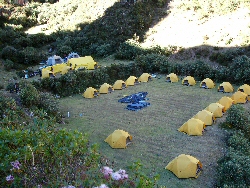 The
long and winding road The
long and winding road
After a very early
morning call, we had breakfast of hot porridge. Most of us were still wearing our thermals! At
6am we started our day's walk, which sometimes takes eight hours, sometimes 12 hours, depending
on the general fitness of the group. We passed mountain streams with lots of icicles on the
grass around it, and did a four hours steady steep climb, most of us with pounding headaches,
to try and reach the highest point of the entire trek, at 4445m.
Here we saw the most stunning views I have ever seen, showing snow capped
mountains in all directions around us. Most of us were quite emotional at this stage, as it was
the culmination of climbing for so many hours. All of us took photos, shook hands and hugged
each other. I was quite proud of myself to have made it up the mountain, without having to
resort to using the horses at all. After a picnic lunch at a river we followed our day's walk,
slightly less strenuously, and mostly downhill, to our next campsite, at the highest level of
the week, at 3960m.
We passed a very small farmhouse, where one of the richest people in the area
lives, by choice, with nothing more than some livestock, her little house and the mountains
around her. Amazing! We had made it to camp in just over eight hours and were rewarded with tea
and popcorn at arrival. Again, after dinner it was an early night, as most of us were quite
simply exhausted.
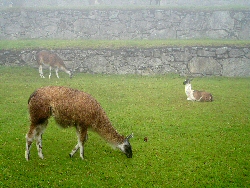 Down,
down, down Down,
down, down
The next morning I
woke up cold, stiff and with a pounding headache. It was 0 degrees C inside the tent, and even
the woolly socks etc. hadn't managed to keep me nice and warm. We had a later start today and
had breakfast outside in the early morning sun, with pancakes. Life doesn't get much better
than that really.
Today was to be a relatively easy walk, along a mountain stream, downhill all
the way, through the Elfin Forest, towards the Sacred Valley. All the time we had a magnificent
view of the Sacred Mountain, Mount Veronica, in the distance, which kept us going. The walk
through the forest was more hot and humid than anything we had encountered before, but when we
came to our lunch spot we forgot all of this. We had lunch at a river, near a waterfall,
sitting on a rock, enjoying these incredible views.
Later that afternoon we visited the farm Max bought a
few years ago, which still needs a lot of work.
Time for a group photo on a big rock, and onwards to the next camp site, at
2981m. The camp was just near a stream of ice cold glacier water, perfect for a dip! Some of us
braved the water for a quick dip, some of us chose to have a proper, but cold, shower. I did
both. We had some free time this afternoon to relax, sunbathe, catch up on writing diaries, or
just have a chat with our newfound friends. I bought a proper Peruvian woolly hat, featuring
llamas of course, from one of the local traders at the campsite.
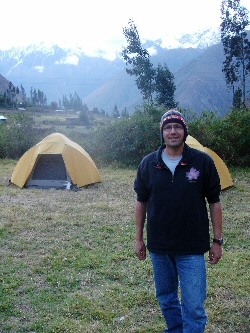 Dinner
was a bit special as well today: potatoes and lamb were prepared in a sort of ‘ground oven' - a
bit like the ‘Hangi' ovens in New Zealand - made by collapsing hot rocks from above a campfire
into a big pile, on which layers of food were heaped, and then covered with cardboard and
plastic and earth. An hour later or so, dinner was ready! Not bad at all in fact. After dinner
we all sat around a big campfire to drink some beers or a glass of wine (for the first time
this week, as alcohol and altitude don't really go together very well). As usual, there were
some people telling jokes and the ‘party' went on for ages. Dinner
was a bit special as well today: potatoes and lamb were prepared in a sort of ‘ground oven' - a
bit like the ‘Hangi' ovens in New Zealand - made by collapsing hot rocks from above a campfire
into a big pile, on which layers of food were heaped, and then covered with cardboard and
plastic and earth. An hour later or so, dinner was ready! Not bad at all in fact. After dinner
we all sat around a big campfire to drink some beers or a glass of wine (for the first time
this week, as alcohol and altitude don't really go together very well). As usual, there were
some people telling jokes and the ‘party' went on for ages.
Hot stuff
The next day we
had a late start, not in the least because of the party the night before, and we all had
breakfast outside again, this time eggs and sausages. We then set off for a short walk through
the Sacred Valley and through a cactus wood. Here we found cacti of some 15ft high!
At about lunchtime we reached our final campsite for the week, and it was a
treat. There were proper toilets, hot showers and even a sauna! Also, some of the tents were
put up underneath a small thatched roof, so they stayed cool. Unfortunately I was in the second
group this day (the whole group of trekkers was divided in two smaller groups for walking on
each day, called the ‘Condors' and the ‘Pumas'), so that they were all taken. Still, we had
lunch, and then had some time to relax and sunbathe again, before some friends and I enjoyed a
very hot and aromatic sauna, before having a shower.
We bought some further souvenirs from the local people and had dinner and
coffee. We were all thinking of the very big day tomorrow, as this was to be the culmination of
the whole week's trek, when we would reach Machu Picchu (MP). It was to be the second hardest
and longest day trekking, but worth it!
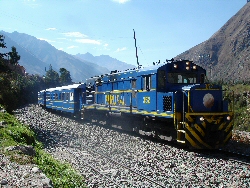 Lost
City found! Lost
City found!
We set off early
in the morning for a short walk to the train station of the ‘Camino Inka', or ‘Inka Trail', at
Piscacucho, at km 82. After some obligatory photographs under the sign we boarded the train, to
get us to km 104, where we were to get off and do the rest on foot. When we got off, we entered
the ‘Machu Picchu National Park', entrance to which is limited to 500 people per day only, to
preserve the state of the paths and staircases used. We were on a tight time schedule, as the
last admission to MP was at 4.30pm. The walk over the ancient Inka Trail paths was a very
arduous one and we must have done thousands of big steep Inka stone steps, in fact so many I
never want to see a stone step ever again!
Lunch today was at a beautiful waterfall once again. A bit later we reached the
famous Inka ruins of Wayna wanya, with fantastic views of the surrounding mountains and clouds.
We were the only people there and each and every one of us got given some time to sit down and
think about our personal reasons behind our trek, the charity we had raised money for, the
people we loved or anything personal really. This was to be quite a satisfying and emotional
time for most of us. After this we only had the rest of the afternoon to reach MP and just then
it started to rain. After all, we were in a ‘cloud forest', and it wasn't green for no reason!
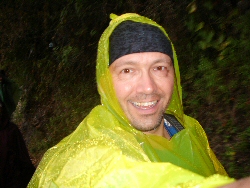 Out
came the ponchos and rainproofs. After many more stone steps, we finally reached the ‘Sun
Gate', through which we were to see the full extent of MP for the first time. Just before we
got to the summit, all the staff lined up to congratulate us on achieving our goal. Finally
walking through the ‘gate' was, again, an emotional moment for most of us, and we all spent
some time taking it all in. After that, there was a 45 minute walk down to MP. Unfortunately,
MP was still looking very grey in the afternoon rain and mist. Out
came the ponchos and rainproofs. After many more stone steps, we finally reached the ‘Sun
Gate', through which we were to see the full extent of MP for the first time. Just before we
got to the summit, all the staff lined up to congratulate us on achieving our goal. Finally
walking through the ‘gate' was, again, an emotional moment for most of us, and we all spent
some time taking it all in. After that, there was a 45 minute walk down to MP. Unfortunately,
MP was still looking very grey in the afternoon rain and mist.
When we got to MP itself, it was still raining and we took some photos, hoping
that, in the morning when we were to return, things would be better for a group photo or two.
All of us were tired, sweaty and wet and we couldn't get to the hotel in Aquas Calientes (Hot
Springs) soon enough, for our promised hot shower.
When we got to the hotel, there was a further surprise waiting for us: within no
time at all the lights went out due to a total powercut! And I mean all the lights, in the
whole of the town! More importantly, the showers weren't working anymore either! By torch light
and candlelight most of us managed to just freshen up a little, before we were to go out in
town for a celebratory ‘gala-dinner'. Amazingly enough, the restaurant was still able to
provide us with a decent meal for over 30 people, cooked on gas stoves, at candlelight! I
suppose they must have done this before. After a nice meal and some speeches we went back to
the hotel, still bathed in candlelight. Surely it was going to be OK in the morning?
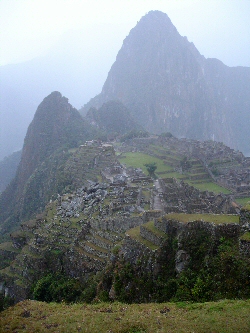 Try
again! Try
again!
The next morning
we got up at 5am, had an early breakfast - yes, in the dark still - and got the bus up to MP
once again, for an early visit, to try and see the first light onto MP this time. After a good
example of how not to run the administrative office of the greatest tourist attraction in the
whole of South America, we finally made it to the entrance to MP, only to see it raining again.
We were promised a two hour tour of the city by our local guides, but this was cut short
slightly due to the weather. MP itself is an amazing place, put on this particular mountain top
for very good reasons, to do with Inka religion and culture in mind. The various temples,
houses and terraces are all in a very good state of repair and the explanation of the guides
made everything more interesting yet. The only slight down point was that by now there were too
many people on the complex, as busload after busload of tourists arrived.
After a coffee it was time for the arranged group photo at the ideal photo spot,
overlooking the entire complex. We all got together, with our cameras in hand, not expecting
many nice shots, when suddenly... the sun came out! In no time at all MP was bathed in
beautiful sunlight, with a backdrop of glorious mountains, still draped in fluffy clouds,
perfect for our photos! We all took the necessary shots, people alone, couples, small groups,
the entire group etc. Some of the trekkers wore the T-shirts of the charity they had done the
trek for, to show them back home they made it to the top.
After the photo shoot, there was an opportunity for some of the group to do a
further two hour climb up Machu Picchu mountain, behind us, for some more impressive views of
the MP city. I chose to go into town for some more coffee and some cheap shopping at the local
market. I bought way too many souvenirs, but at those prices, who can blame me? After some
relaxing in a bar overlooking the main square it was time for lunch in a restaurant before the
trip back to Cuzco, by train and coach.
Late in the evening we arrived in Cuzco at a nice hotel, where there was
actually power! We went out in small groups for a late evening dinner around the main square.
Some friends and I found the well known ‘Inka Grill' and enjoyed a nice meal with some bubbly!
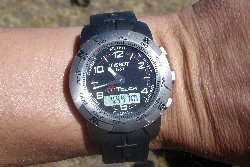 The
long, long way home The
long, long way home
The next day there was
just the small matter of getting back to the UK. This involved three more flights, some free
time in Lima and a lot of time sitting in airports. Finally, on Friday the 13th, we
all arrived back in the UK in one piece. After some heart wrenching goodbyes we all went our
way to our homes, to tell our loved ones what we had achieved and experienced. We were all
tired, jet lagged and quite emotional after such an amazing trek, but richer for it. We brought
home souvenirs, photos, walking sticks and much more, but, more importantly, had one of the
most fantastic experiences of our lives and started some beautiful friendships. Would I do it
again? You bet! These challenge treks are a bit addictive, you know. I've now done three, all
amazing, all interesting in their own right, all very different though, and I can't wait to do
another, hopefully with some of my newfound friends.
Next stop: The Great Wall of China probably. Watch this space.
More Pictures
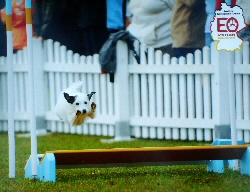 About
the author About
the author
Peter van Dongen qualified as a vet at the Utrecht Veterinary school, The
Netherlands, in March 1990. He worked in a mixed practice in Louth, Lincolnshire, UK, for three
years, before deciding to limit himself to small animals only. In 1993 he joined Pennard
Veterinary Group, in Sevenoaks, Kent. From December 1996 till January 2005 he ran his own
branch practice in Allington, Maidstone. Currently he is a Director at Pennard Veterinary
Group, now a 13 vet, four branch, small animal veterinary practice. His special interests are
surgery, orthopaedics, radiology and, more recently, Canine Sports Medicine. He has just set up
a hydrotherapy service at his practice.
In May 1995 Peter started agility (after years of just thinking about it!) with
his Jack Russell X 'Basil' (a bitch!), then five years old. Since then they qualified for many
finals, including Crufts and Olympia. Basil won the coveted Crufts 2001 title in the individual
Mini Agility. Peter’s little Jack Russell X, Sky, is now at Grade 6 and has recently taken part
in the European Open Agility Championships.
Peter passed the British Agility Club Instructors' exam in October 1999 (first
class) and then did the British Agility Club Judging Workshop. Peter regularly writes for
various agility magazines and web sites and has been the official British Team Vet for the
Agility World Championships for the last seven years.
Since last year Peter has started to do yearly charity treks, first to the
Norwegian Arctic, then to the Namibian desert and this year to Machu Picchu in Peru.
| |
|
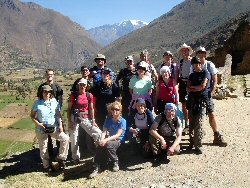
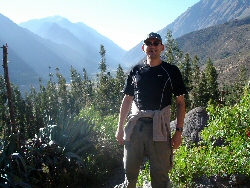
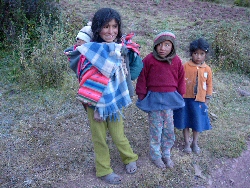
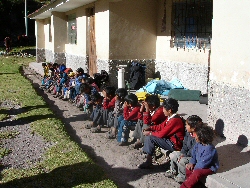
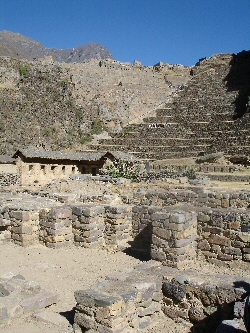
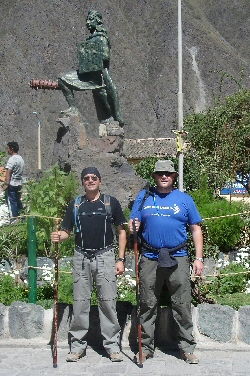
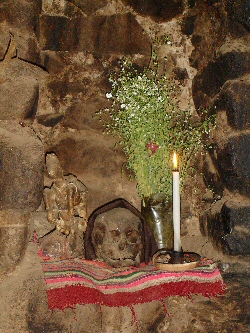
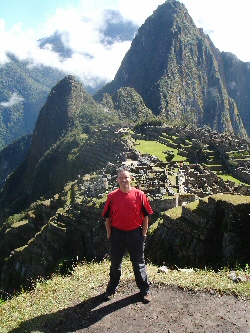
 About
the author
About
the author